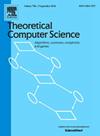Monitoring arc-geodetic sets of oriented graphs
IF 0.9
4区 计算机科学
Q3 COMPUTER SCIENCE, THEORY & METHODS
引用次数: 0
Abstract
Monitoring edge-geodetic sets in a graph are subsets of vertices such that every edge of the graph must lie on all the shortest paths between two vertices of the monitoring set. These objects were introduced in a work by Foucaud, Krishna and Ramasubramony Sulochana with relation to several prior notions in the area of network monitoring like distance edge-monitoring.
In this work, we explore the extension of those notions unto oriented graphs, modelling oriented networks, and call these objects monitoring arc-geodetic sets. We also define the lower and upper monitoring arc-geodetic number of an undirected graph as the minimum and maximum of the monitoring arc-geodetic number of all orientations of the graph. We determine the monitoring arc-geodetic number of fundamental graph classes such as bipartite graphs, trees, cycles, etc. Then, we characterize the graphs for which every monitoring arc-geodetic set is the entire set of vertices, and also characterize the solutions for tournaments. We also cover some complexity aspects by studying two algorithmic problems. We show that the problem of determining if an undirected graph has an orientation with the minimal monitoring arc-geodetic set being the entire set of vertices, is NP-hard. We also show that the problem of finding a monitoring arc-geodetic set of size at most k is NP-complete when restricted to oriented graphs with maximum degree 4.
求助全文
约1分钟内获得全文
求助全文
来源期刊

Theoretical Computer Science
工程技术-计算机:理论方法
CiteScore
2.60
自引率
18.20%
发文量
471
审稿时长
12.6 months
期刊介绍:
Theoretical Computer Science is mathematical and abstract in spirit, but it derives its motivation from practical and everyday computation. Its aim is to understand the nature of computation and, as a consequence of this understanding, provide more efficient methodologies. All papers introducing or studying mathematical, logic and formal concepts and methods are welcome, provided that their motivation is clearly drawn from the field of computing.
 求助内容:
求助内容: 应助结果提醒方式:
应助结果提醒方式:


